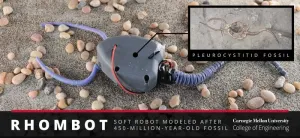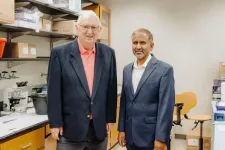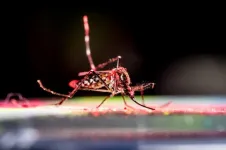(Press-News.org) Researchers at North Carolina State University have created a land change model that simulates interactions between urban growth, increased flooding and how humans adapt in response. The new model could offer a more realistic assessment of risk for urban planners, natural resource managers and other local government stakeholders.
“Traditional risk assessment typically involves overlaying inundation layers – areas that may flood – onto existing development or population distribution to identify areas and communities at risk,” says Georgina Sanchez, research scholar in NC State’s Center for Geospatial Analytics and corresponding author of the work. “Yet this approach only provides a partial picture.
“Urban planners and residents are increasingly aware of the growing flood risks from climate change and are ready to respond and adapt when able,” Sanchez says. “It’s crucial for models to consider our collective adaptation efforts – like elevating buildings or moving away from high-risk zones. Our model provides deeper insights, helping us understand adaptive capacities and identify communities with limited resources – essentially characterizing the geography of impact and response.”
The model, FUTURES 3.0 (FUTure Urban-Regional Environment Simulation), is an open-source, scalable model that includes three components of flood risk: exposure, which refers to urban development patterns; hazard, which includes increases in flooding due to climate change; and vulnerability, or the adaptive response of people living in the area. The model incorporates climate data as well as demographic, socio-economic and flood-damage data.
The researchers used the greater Charleston (S.C.) metropolitan area as their test case. Charleston is a rapidly developing urban area located in a low-lying region bordered by the Atlantic Ocean and numerous rivers.
By comparing land change projections for 2035 and 2050 against a 2020 baseline and across various policy intervention and response scenarios, they envisioned possible demographic and population shifts and identified which scenarios resulted in the least exposure to future flooding, as well as where flood risk remained highest across the landscape.
“The study underscores the importance of incorporating human adaptive response alongside demographic shifts and urban expansion for accurate exposure and risk assessment,” Sanchez says. “Not all residents or communities will have the means or capacity to build protective measures. Visualizing potential ‘what-if’ scenarios help us consider the where and when of impact and understand who is being affected and how.”
The researchers’ next steps are to engage with communities to discuss potential interventions. They are also expanding their studies at a regional scale.
“Through scenario-based modeling,” Sanchez says, “we explore questions like: how will communities respond to damage, who has the means to adapt, and what challenges do those with limited resources for protection face?
“Additionally, these scenarios let us visualize the long-term consequences of our current development choices,” Sanchez continues. “If we anticipate that 30 years from now a newly developed community may face the decision to retreat, why not think about protecting that area now?”
The work appears in Scientific Reports and is supported by the U.S. Geological Survey Southeast Climate Adaptation Science Center, the National Science Foundation program for Smart and Connected Communities, and the intramural research program of the U.S. Department of Agriculture, National Institute of Food and Agriculture, McIntire-Stennis. The open-source FUTURES software can be accessed through the GitHub repository (https://github.com/ncsu-landscape-dynamics/GRASS_FUTURES) with the identifier doi:10.5281/zenodo.6607097.
-peake-
Note to editors: An abstract follows.
“Spatially interactive modeling of land change identifies location-specific adaptations most likely to lower future flood risk”
DOI: 10.1038/s41598-023-46195-9
Authors: Georgina M. Sanchez, Anna Petrasova, Megan M. Skrip, Elyssa L. Collins, Margaret A. Lawrimore, John B. Vogler, Jelena Vukomanovic, Helena Mitasova, Ross K. Meentemeyer, North Carolina State University; Adam Terando, North Carolina State University and U.S. Geological Survey
Published: Nov. 1, 2023 in Scientific Reports
Abstract:
Impacts of sea level rise will last for centuries; therefore, flood risk modeling must transition from identifying risky locations to assessing how populations can best cope. We present the first spatially interactive (i.e., what happens at one location affects another) land change model (FUTURES 3.0) that can probabilistically predict urban growth while simulating human migration and other responses to flooding, essentially depicting the geography of impact and response. Accounting for human migration reduced total amounts of projected developed land exposed to flooding by 2050 by 5%–24%, depending on flood hazard zone (50%–0.2% annual probability). We simulated various “what-if” scenarios and found managed retreat to be the only intervention with predicted exposure below baseline conditions. In the business-as-usual scenario, existing and future development must be either protected or abandoned to cope with future flooding. Our open framework can be applied to different regions and advances local to regional-scale efforts to evaluate potential risks and tradeoffs.
END
EVANSTON, Ill., --- New research shows large reductions in gun violence involvement for participants of a Chicago-based community violence intervention (CVI) program.
Researchers from Northwestern University evaluated outcomes for the Chicago CRED (Create Real Economic Destiny) program and found that those who completed the full program were more than 73% less likely to have an arrest for a violent crime in the two years following enrollment compared to individuals who did not participate.
Analyzing program participation, the researchers ...
EMBARGOED UNTIL: 6, NOVEMBER, 2023, 3 PM US EASTERN
A groundbreaking study published in the Proceedings of the National Academy of Sciences underscores the pivotal role that seasonal Antarctic sea ice plays in the annual molting periods of Adélie penguins. Despite the relatively large amount of sea ice still available in the Ross Sea, researchers have discovered a potential bottleneck in the penguins’ annual cycle, which could be exacerbated as the climate continues to change.
Unlike most penguin species, the majority of Adélie penguins are thought to carry out their annual molt ...
PITTSBURGH—Researchers in the Department of Mechanical Engineering at Carnegie Mellon University, in collaboration with paleontologists from Spain and Poland, used fossil evidence to engineer a soft robotic replica of pleurocystitid, a marine organism that existed nearly 450 million years ago and is believed to be one of the first echinoderms capable of movement using a muscular stem.
Published today in The Proceedings of the National Academy of Science (PNAS), the research seeks to broaden modern perspective of animal design and movement by introducing a new a field of study - Paleobionics - aimed at using Softbotics, robotics ...
City lights shine all night amid the bustling traffic, businesses and neighborhoods of Southern California, one of the most populated areas that mountain lions call home.
A study from the University of California, Davis, found that mountain lions avoid places with artificial light, even during the day. The finding adds to the list of challenges faced by the big cats in the region, where scientists have warned they may face extinction within decades.
The new study, published in the journal Philosophical ...
A drug candidate developed by researchers at the University of Tennessee Health Science Center for advanced metastatic castration-resistant prostate cancer is now in its first clinical trial.
Ramesh Narayanan, PhD, deputy director of the Center for Cancer Research and the Muirhead Endowed Professor in the College of Medicine at UTHSC, and Duane Miller, PhD, Professor Emeritus in the Department of Pharmaceutical Sciences at UTHSC, have worked for more than a decade on therapies involving the hormone receptors that influence cancer progression. Their drug candidate, a molecule designed as a treatment for ...
A new mathematical model predicts that mammalian sperm cells have two distinct swimming modes. This prediction opens new questions about potential connections between sperm cells’ motor activity and their transitions to hyperactivation phases that may play an important role in fertilization. The finding is part of a larger effort to use math and fluid dynamics to describe how mammalian sperm move. The research is led by a team of engineers at the University of California San Diego. The new work is published in the journal Physical ...
NEW ORLEANS, La. – Several Ochsner Health hospitals and partners across the Gulf South have earned an ‘A’ Leapfrog Hospital Safety Grade for Fall 2023.The Leapfrog Group, a national nonprofit watchdog that sets standards for excellence in patient care, assigns a grade to general hospitals across the country based on more than 30 national performance measures reflecting errors, accidents, injuries and infections, as well as the systems hospitals have in place to prevent them.
The following Ochsner Health hospitals and partners received an ...
Technology is edging closer and closer to the super-speed world of computing with artificial intelligence. But is the world equipped with the proper hardware to be able to handle the workload of new AI technological breakthroughs?
“The brain-inspired codes of the AI revolution are largely being run on conventional silicon computer architectures which were not designed for it,” explains Erica Carlson, 150th Anniversary Professor of Physics and Astronomy at Purdue University.
A joint effort between Physicists from Purdue University, University of California San Diego (USCD) and École ...
Researchers at the Beckman Institute for Advanced Science and Technology developed an automated laboratory robot to run complex electrochemical experiments and analyze data.
With affordability and accessibility in mind, the researchers collaboratively created a benchtop robot that rapidly performs electrochemistry. Aptly named the Electrolab, this instrument greatly reduces the effort and time needed for electrochemical studies by automating many basic and repetitive laboratory tasks.
The Electrolab can be used to explore energy storage materials and chemical reactions that promote the use of alternative ...
The fight against dengue fever has a new weapon: a mosquito infected with the bacteria Wolbachia, which prevents the spread of the virus. These mosquitoes have now been deployed in several trials demonstrating their potential in preventing disease transmission.
Now, researchers at the University of Notre Dame have conducted an analysis of the World Mosquito Program’s randomized control trial of Wolbachia-infected mosquitoes in Indonesia, looking at how excluding transmission dynamics impacted the original interpretation of the trial’s results.
“Randomized controlled trials are the gold standard for evaluating the efficacy of any ...





